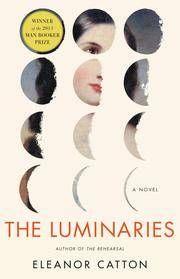
Read This, Then That: THE LUMINARIES and THE MOONSTONE
In Read This, Then That, we pair new books with classics that have similar themes, structures, and stories.

As he sits in the hotel’s smoking room, Moody is finally approached by one of the men, who begins an awkward and somewhat prying conversation. Moody can see the others are listening, and reluctantly shares some personal history that reveals to the other men that he might be able to help them. So they decide to spill it: they are connected, by a mysterious chain of events none of them fully understands that involves gold, a mysterious death, and a whole lot more. Since none of them know the whole tale, they take turns, each telling his own share in it with an omniscient third-person narrator to keep track of everything and clean it all up.
Balfour’s narrative, made somewhat circuitous by interruption, and generally encumbered by the lyrical style of that man’s speech, became severely muddled in the telling, and several hours passed before Moody finally understood with clarity the order of events that had precipitated the secret council in the hotel smoking room.
The interruptions were too tiresome, and Balfour’s approach too digressive, to deserve a full and faithful record in the men’s own words. We shall here excise their imperfections, and impose a regimental order upon the impatient chronicle of the shipping agent’s roving mind; we shall apply our own mortar to the cracks and chinks of earthly recollection, and resurrect as new the edifice that, in solitary memory, exists only as a ruin.
This approach leaves the narrator free to build and demolish as she sees fit, to make the completest revelation of the story possible. The men of Hokitika may be unreliable, messy narrators, but The Luminaries has someone who can whip them into shape—who can make them fit into their rightful places in the broader landscape. Moody plays, to some extent, the part of amateur detective: he too is puzzling out how the men’s stories fit together, using his little grey cells to examine the details and decide how each player’s own personal truth interlocks with all the others. But it’s the narrator who actually presents the finished result to the reader, and all that brick and mortar is surely key to Catton’s astrology-inspired structure of the novel as a whole.

The Moonstone is an epistolary novel. Instead of a third-person omniscient narrator, like the one who stitches the various bits of The Luminaries together into one coherent story, The Moonstone asks the reader to do the stitching. Gabriel Betteredge, the steward of the house where the principle events of the story take place, provides the first document, which explains itself thus.
“We have certain events to relate,” Mr. Franklin proceeded; “and we have certain persons concerned in those events who are capable of relating them. Starting from these plain facts, the idea is that we should all write the story of the Moonstone in turn—as far as our own personal experience extends, and no farther. We must begin by showing how the Diamond first fell into the hands of my uncle Herncastle, when he was serving in India fifty years since. This prefatory narrative I have already got by me in the form of an old family paper, which relates the necessary particulars on the authority of an eye-witness. The next thing to do is to tell how the Diamond found its way into my aunt’s house in Yorkshire, two years ago, and how it came to be lost in little more than twelve hours afterwards. Nobody knows as much as you do, Betteredge, about what went on in the house at that time. So you must take the pen in hand, and start the story.”
And so he has. The self-awareness of Betteredge’s tale and how it fits into a larger whole sets a different tone from Catton’s. Where the narrator of The Luminaries is mostly concerned with cleaning up language and chronology to make things sound and feel like a whole, the warring narrators of The Moonstone are just that. “I hear you are likely to be turned over to Miss Clack, after parting with me,” Betteredge tells us. “In that case, just do me the favour of not believing a word she says, if she speaks of your humble servant.” And he’s not the only one to talk of his fellow contributors. Franklin Blake, organizer of the whole project, footnotes Miss Clack’s report and says, in one of his own, that “[t]he picture presented of me, by my old friend Betteredge, at the time of my departure from England, is (as I think) a little overdrawn.”
The Moonstone may have a detective, unlike The Luminaries, but its mystery is, in some ways, solve-it-yourself. It makes for an interesting contrast to the newer novel, where the closest thing to a detective may not have solved the mystery at all, in the end, but the narrator has made it pretty plain to the reader. Here, instead, we are directly confronted by unreliable narrators without a safe mediator, to fill in all those chinks for ourselves.
_________________________
Sign up for our newsletter to have the best of Book Riot delivered straight to your inbox every week. No spam. We promise.
To keep up with Book Riot on a daily basis, follow us on Twitter, like us on Facebook, , and subscribe to the Book Riot podcast in iTunes or via RSS. So much bookish goodness–all day, every day.

















